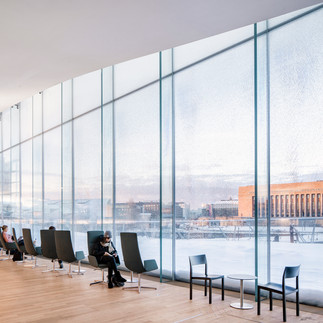Library That Over Half the City Visits Every Month
- Editor OGN Daily
- Dec 11, 2022
- 2 min read
Updated: Feb 3
Helsinki is home to a remarkable new library concept that provides a blueprint for fostering human convergence.

Finland's capital city is home to 1.3 million people, and since opening in 2018, the Oodi Library is writing a new chapter in the history of public space. Instead of being merely a repository for books, it's an alternative working and learning space, a cultural and community centre, and a platform for democracy and citizen initiatives - and attracts people of all ages.
Anyone can enter and use the facilities, many of which are free, without needing to provide ID. And, against the trend elsewhere in the world, half of the city's residents use the Oodi Library every month.
The country’s flagship library, located opposite the Finnish Parliament - perhaps signifying that learning is as important as politics - aims to “embrace technology and progressive values” to provide a variety of innovative services alongside its lending collection of books. In fact, the 17,250 sq.m (185,000 sq. ft.) building contains a relatively small number of books - around 100,000. Two thirds of its space is dedicated to public amenities including a cinema, recording studios, a maker space, family play areas, and facilities for staging exhibitions and events. All housed in a light, airy, beautifully designed, welcoming environment that is as much a social space as a practical one.
With the rise of digital tech and the associated lifestyle changes, plus cuts to spending on municipal services around the world, many fear the demise of the traditional library. For example, public library use fell by 31 percent over eight years in the US, according to the Freckle Report, and in the UK it is now 70 percent less than it was in 2000. So, Finland’s large-scale investment in the public library system takes a radically different path to that of the United States and Britain, and Oodi’s success is a welcome plot twist. The result: some 50 percent of citizens use the library at least once a month, and 20 percent use it weekly.
The library’s success is the result of more than two decades of participatory planning and consultation that put the public at the centre of the discussion, creating a library not designed for them, but with them. More than 3,000 citizens took part in this process, giving citizens the ability to vote and comment on the library’s architectural design, and participatory budgeting, which allowed Finns to collectively spend €100,000 (approx $100,000) of Oodi’s budget.
Enabling Finland’s approach is a legal framework known as the Library Act, which outlines key objectives such as improving literacy, making information readily available to the public, and promoting equality. This holistic, participatory method has paid off: Public libraries are the most popular cultural institutions in Finland.















